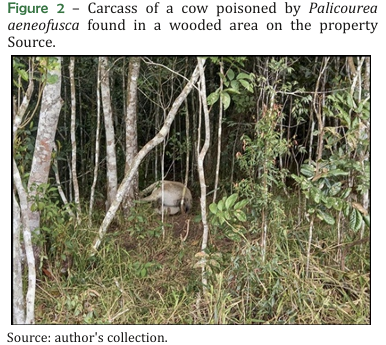Spontaneous poisoning by Palicourea aeneofusca (Müll.Arg.) Standl. in cattle in the agreste region of Pernambuco
DOI:
https://doi.org/10.21708/avb.2025.19.1.12858Abstract
Plants containing monofluoroacetic acid constitute an important group responsible for poisoning in ruminants. In this sense, Palicourea aeneofusca stands out for being the main representative of these plants in the Agreste region of Pernambuco, Northeast Brazil, causing considerable economic losses. Therefore, the objective of this study is to describe the epidemiological, clinical, and pathological aspects of two outbreaks of spontaneous poisoning caused by P. aeneofusca in cattle in this region. Technical visits were carried out on two properties (A and B) with reports of sudden death in cattle, between August and September 2023, in two municipalities in the Southern Agreste region of Pernambuco. Epidemiological data were collected, in addition to inspection of pastures and identification of plants with toxic potential. Two cattle that died, one from each of the respective properties, were subjected to necropsy examination with collection of material for histopathological evaluation. P. aeneofusca was identified as the cause of cattle poisoning on the properties, both of which maintain preserved forest areas within their territory. In total, four cattle from property A (herd of 60 animals) and one animal from property B (herd of seven animals) died. The histopathological evaluation revealed hydropic-vacuolar degeneration in the cytoplasm of tubular epithelial cells and multifocal lymphocytic myocarditis with small hemorrhagic foci. Epidemiological data, histopathological lesions, and botanical identification of the plant were used as elements to confirm the diagnosis of poisoning by P. aeneofusca, confirming the negative impact of poisoning by this plant on cattle herds in the region.
.
Downloads

Downloads
Published
Issue
Section
License
Copyright (c) 2025 Acta Veterinaria Brasilica

This work is licensed under a Creative Commons Attribution 4.0 International License.
Autores que publicam na Acta Veterinaria Brasilica concordam com os seguintes termos: a) Autores mantém os direitos autorais e concedem à revista o direito de primeira publicação, com o trabalho simultaneamente licenciado sob a Licença Creative Commons Attribution que permite o compartilhamento do trabalho com reconhecimento da autoria e publicação inicial nesta revista. b) Autores têm autorização para assumir contratos adicionais separadamente, para distribuição não-exclusiva da versão do trabalho publicada nesta revista (ex.: publicar em repositório institucional ou como capítulo de livro), com reconhecimento de autoria e publicação inicial nesta revista. c) Autores têm permissão e são estimulados a publicar e distribuir seu trabalho online (ex.: em repositórios institucionais ou na sua página pessoal) a qualquer ponto antes ou durante o processo editorial, já que isso pode gerar alterações produtivas, bem como aumentar o impacto e a citação do trabalho publicado (Veja O Efeito do Acesso Livre).


 Esta obra está licenciada com uma Licença
Esta obra está licenciada com uma Licença 